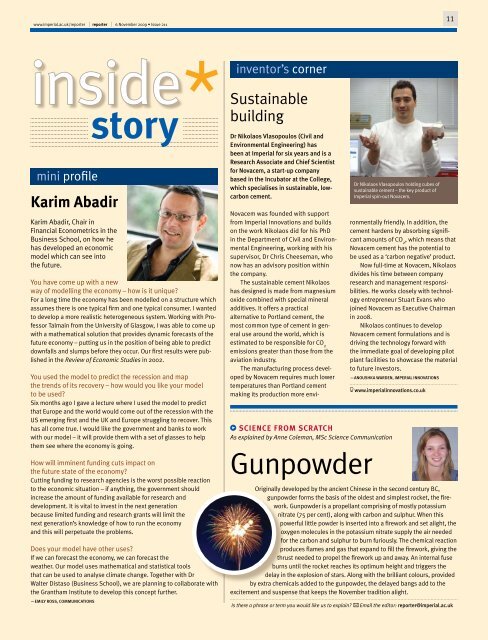211 pdf - Imperial College London
211 pdf - Imperial College London
211 pdf - Imperial College London
You also want an ePaper? Increase the reach of your titles
YUMPU automatically turns print PDFs into web optimized ePapers that Google loves.
www.imperial.ac.uk/reporter | reporter | 6 November 2009 • Issue <strong>211</strong><br />
11<br />
inside<br />
story<br />
mini profile<br />
Karim Abadir<br />
Karim Abadir, Chair in<br />
Financial Econometrics in the<br />
Business School, on how he<br />
has developed an economic<br />
model which can see into<br />
the future.<br />
You have come up with a new<br />
way of modelling the economy – how is it unique?<br />
For a long time the economy has been modelled on a structure which<br />
assumes there is one typical firm and one typical consumer. I wanted<br />
to develop a more realistic heterogeneous system. Working with Professor<br />
Talmain from the University of Glasgow, I was able to come up<br />
with a mathematical solution that provides dynamic forecasts of the<br />
future economy – putting us in the position of being able to predict<br />
downfalls and slumps before they occur. Our first results were published<br />
in the Review of Economic Studies in 2002.<br />
You used the model to predict the recession and map<br />
the trends of its recovery – how would you like your model<br />
to be used?<br />
Six months ago I gave a lecture where I used the model to predict<br />
that Europe and the world would come out of the recession with the<br />
US emerging first and the UK and Europe struggling to recover. This<br />
has all come true. I would like the government and banks to work<br />
with our model – it will provide them with a set of glasses to help<br />
them see where the economy is going.<br />
How will imminent funding cuts impact on<br />
the future state of the economy?<br />
Cutting funding to research agencies is the worst possible reaction<br />
to the economic situation – if anything, the government should<br />
increase the amount of funding available for research and<br />
development. It is vital to invest in the next generation<br />
because limited funding and research grants will limit the<br />
next generation’s knowledge of how to run the economy<br />
and this will perpetuate the problems.<br />
Does your model have other uses?<br />
If we can forecast the economy, we can forecast the<br />
weather. Our model uses mathematical and statistical tools<br />
that can be used to analyse climate change. Together with Dr<br />
Walter Distaso (Business School), we are planning to collaborate with<br />
the Grantham Institute to develop this concept further.<br />
—Emily Ross, Communications<br />
inventor’s corner<br />
Sustainable<br />
building<br />
Dr Nikolaos Vlasopoulos (Civil and<br />
Environmental Engineering) has<br />
been at <strong>Imperial</strong> for six years and is a<br />
Research Associate and Chief Scientist<br />
for Novacem, a start-up company<br />
based in the Incubator at the <strong>College</strong>,<br />
which specialises in sustainable, lowcarbon<br />
cement.<br />
Novacem was founded with support<br />
from <strong>Imperial</strong> Innovations and builds<br />
on the work Nikolaos did for his PhD<br />
in the Department of Civil and Environmental<br />
Engineering, working with his<br />
supervisor, Dr Chris Cheeseman, who<br />
now has an advisory position within<br />
the company.<br />
The sustainable cement Nikolaos<br />
has designed is made from magnesium<br />
oxide combined with special mineral<br />
additives. It offers a practical<br />
alternative to Portland cement, the<br />
most common type of cement in general<br />
use around the world, which is<br />
estimated to be responsible for CO 2<br />
emissions greater than those from the<br />
aviation industry.<br />
The manufacturing process developed<br />
by Novacem requires much lower<br />
temperatures than Portland cement<br />
making its production more environmentally<br />
friendly. In addition, the<br />
cement hardens by absorbing significant<br />
amounts of CO 2<br />
, which means that<br />
Novacem cement has the potential to<br />
be used as a ‘carbon negative’ product.<br />
Now full-time at Novacem, Nikolaos<br />
divides his time between company<br />
research and management responsibilities.<br />
He works closely with technology<br />
entrepreneur Stuart Evans who<br />
joined Novacem as Executive Chairman<br />
in 2008.<br />
Nikolaos continues to develop<br />
Novacem cement formulations and is<br />
driving the technology forward with<br />
the immediate goal of developing pilot<br />
plant facilities to showcase the material<br />
to future investors.<br />
—Anoushka Warden, <strong>Imperial</strong> Innovations<br />
www.imperialinnovations.co.uk<br />
science from scratch<br />
As explained by Anne Coleman, MSc Science Communication<br />
Gunpowder<br />
Originally developed by the ancient Chinese in the second century BC,<br />
gunpowder forms the basis of the oldest and simplest rocket, the firework.<br />
Gunpowder is a propellant comprising of mostly potassium<br />
nitrate (75 per cent), along with carbon and sulphur. When this<br />
powerful little powder is inserted into a firework and set alight, the<br />
oxygen molecules in the potassium nitrate supply the air needed<br />
for the carbon and sulphur to burn furiously. The chemical reaction<br />
produces flames and gas that expand to fill the firework, giving the<br />
thrust needed to propel the firework up and away. An internal fuse<br />
burns until the rocket reaches its optimum height and triggers the<br />
delay in the explosion of stars. Along with the brilliant colours, provided<br />
by extra chemicals added to the gunpowder, the delayed bangs add to the<br />
excitement and suspense that keeps the November tradition alight.<br />
Is there a phrase or term you would like us to explain?<br />
Dr Nikolaos Vlasopoulos holding cubes of<br />
sustainable cement – the key product of<br />
<strong>Imperial</strong> spin-out Novacem.<br />
Email the editor: reporter@imperial.ac.uk

















